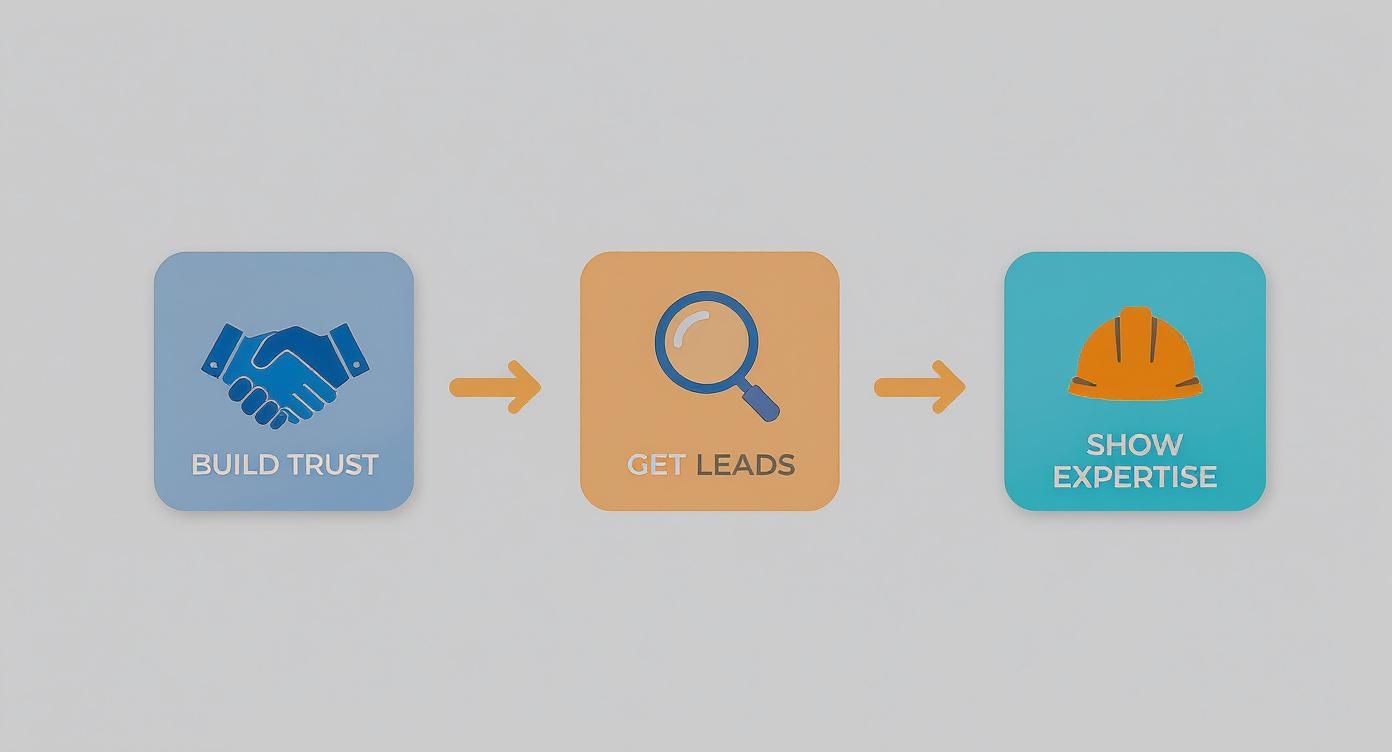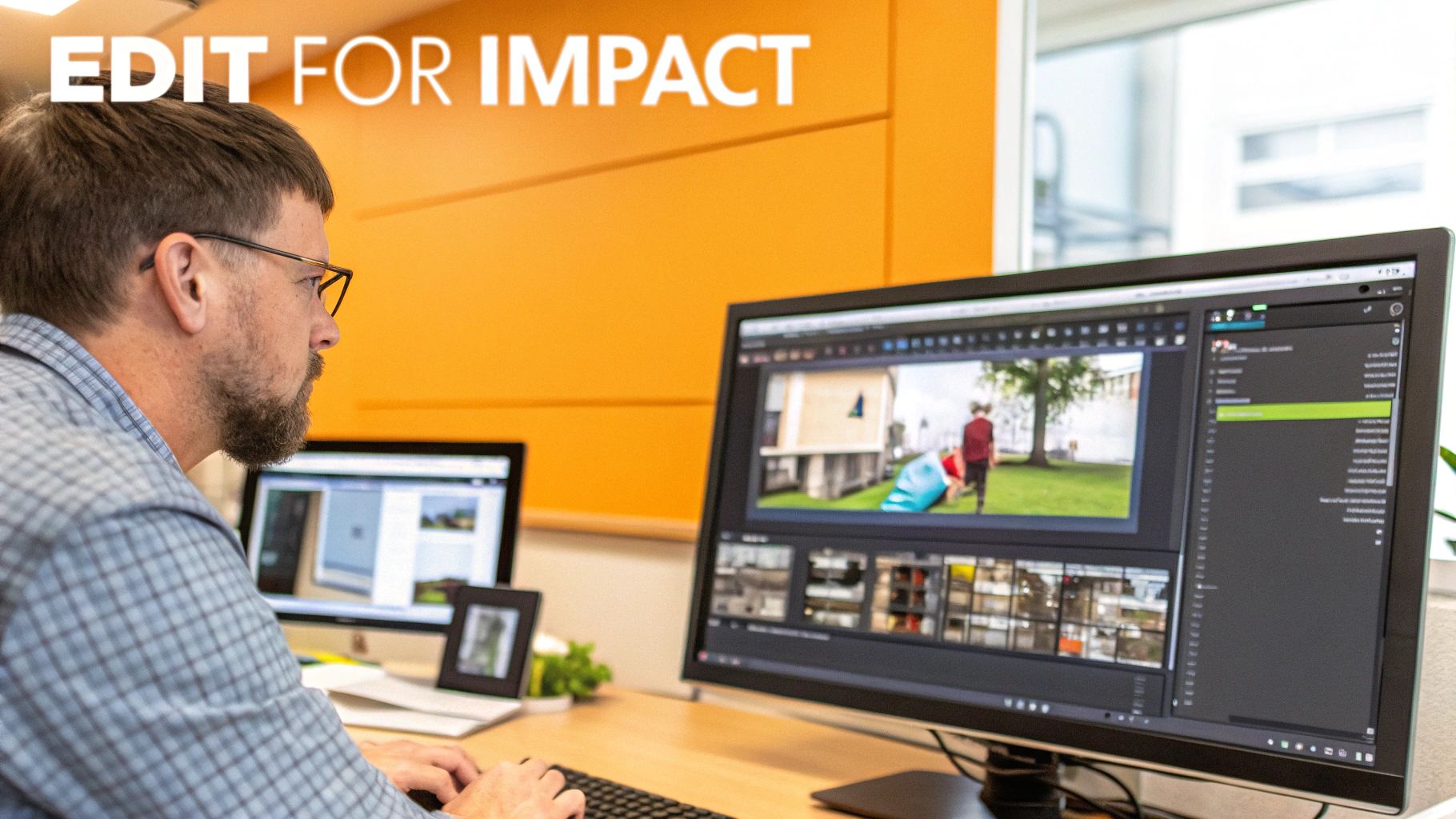


Construction video proves your expertise before a client even calls. It's the best way to show the quality of your work, the professionalism of your team, and the scale of your projects. It turns your craft into a powerful marketing tool that helps you win better bids.
Photos on your website are the bare minimum. They’re expected, but they don’t make you stand out. A photo shows a finished product, but it can’t capture the process, the skill, or the story behind a successful build. This is where professional video changes the game.
Video builds trust, fast. It gives potential clients a real feel for who you are and what it’s like to work with your company.
Seeing your team in action—from the foundation pour to the final handover—adds a layer of transparency and credibility that static images can't match. It’s the difference between telling someone you're good and showing them.
Good construction video production isn't a one-trick pony. Different types of videos serve specific purposes, and each one helps strengthen your brand and pull in better leads.
The goal is to create assets that show your expertise and give potential clients the confidence to choose you. A great video isn't just content; it's a tool that generates leads.
This isn't just about looking slick; it's smart business. New Zealand's screen sector has a deep talent pool. This means high-quality, professional video is more accessible for Kiwi builders than ever. By tapping into this, you’re creating powerful marketing that works for you 24/7.
To see how we turn builds into brands, check out the Onsite Media blog.
Like any good build, a powerful construction video starts with a solid plan. Jumping straight into filming without a clear strategy is like starting a project without blueprints. It wastes time and money, and the final product rarely hits the mark.
The pre-production phase is where the real work gets done. It's where you make sure every shot and every interview works toward a specific business goal.
First, lock down that goal. What are you trying to achieve? Maybe you want to attract high-end residential clients in Queenstown with a portfolio of architectural homes. Or perhaps the goal is to showcase your commercial expertise to win bigger tenders in Auckland. Your answer shapes every decision, from the visual style to the key messages. Think of it as your compass.
Once you know who you’re talking to, figure out what you want to say. This isn’t about writing a stuffy script. It’s about outlining the three or four key takeaways you want a potential client to remember.
Keep these points simple and direct. For example:
Your shot list is your practical guide for filming day. It's a checklist detailing every scene you need to capture, making sure nothing gets missed. For a residential project, a good shot list might include the foundation pour, the frame standing, and the final client walkthrough.
This infographic breaks down how a well-planned video translates into real business growth.
By focusing on these outcomes, your video stops being a visual record and becomes a hard-working strategic tool.
Finally, let's talk logistics. Scheduling filming around critical construction milestones requires careful coordination with your project manager and crew. A professional video team understands the realities of a construction site. They know how to work safely and efficiently without getting in your way.
Pre-production is non-negotiable. It’s the groundwork that ensures your video connects with the right audience, communicates your value, and helps you win more work.
All this planning feeds into a smarter content strategy. To get more ideas on turning your projects into powerful marketing, check out our guide on builder content creation. A good plan turns your video from an expense into an investment in your company's growth.
This is where the story of your craftsmanship comes to life. Forget fussy camera tricks. Great construction video production is about capturing the build with honesty and purpose. Every shot needs to contribute to the story you’re telling your ideal client.
The goal is to create a dynamic visual story. You’ll want a mix of wide, establishing shots that show the scale of the project—like a drone soaring over a new build in Tauranga—paired with tight, detailed close-ups. It's these close-ups that sell the quality, highlighting premium materials or the precision of your team's work, like a perfectly finished join.

Certain phases of a project are gold on camera. Filming these moments gives viewers a sense of progress and shows what your team can do. Make sure your camera is rolling for these milestones:
Time-lapses are a game-changer. They condense months of hard work into a few captivating seconds, offering a powerful perspective on the entire build process.
To help you plan your shoot, here's a quick checklist of essential shots. A plan like this ensures you leave the site with all the footage needed to tell a complete and compelling story.
Having a variety of these shots gives your editor everything they need to piece together a video that’s not just informative, but genuinely engaging.
A video of just machinery and materials only tells half the story. To build real trust, you need to show the people behind the project. Brief, informal interviews on-site are one of the most effective ways to do this.
Pull the project manager aside for a quick chat about a challenge they’ve overcome, or ask a lead carpenter to explain the thinking behind a feature they're proud of. Even better, if the client is on-site and happy to talk, capturing their genuine excitement is pure marketing gold. These unscripted moments add an authenticity that makes your company feel more relatable and trustworthy.
Getting this done professionally is easier than you think. New Zealand has a highly skilled production industry—the Motion Picture and Video Production sector has a market size of about NZ$1.6 billion, meaning the right gear and expertise are available. You can dig into the details about NZ's video production industry size on IBISWorld. This access to talent means you can get professional-grade results for any project.
Your goal on filming day is simple: gather authentic, high-quality footage that tells a powerful story about what your company can do. When you focus on both the grand scale and the fine details, you create an asset that proves your value and helps you win better work.
Once the cameras are packed away, the real work begins. All that great footage from site—the sweeping drone shots, the detailed close-ups, the time-lapses—is just the raw material. In post-production, a skilled editor weaves those pieces together to build a compelling story that reflects your brand and wins you more work.
This is more than just stringing clips together; it's a craft. A good editor sifts through hours of footage to find the best moments, sequencing them to create a natural rhythm that holds a viewer's attention. This is how you transform a simple recording into a marketing asset that shows off the quality of your builds.
If you want to understand the broader principles of video making, this practical guide to video creation is a helpful resource.

Music and sound design are critical for setting the right vibe. An energetic track might be perfect for a commercial project targeting developers, while a more cinematic score could be a better fit for a high-end architectural home. It’s a subtle but powerful tool for connecting with your ideal client.
Then you have colour grading. This is what gives your video that polished, professional look. An editor adjusts the colours to make them pop, ensuring the final product looks crisp and vibrant. It's this fine-tuning that elevates the entire production, making sure your work is presented in the best possible light.
The editing suite is where we make sure every frame works hard for your business. It’s the final quality check that turns good footage into a video that builds trust and drives enquiries.
Simple graphics also pack a punch. Adding your company logo, the project's location, or the architect’s name helps reinforce your brand and gives viewers valuable context. These small touches add a layer of professionalism that makes your videos stand out.
Finding top-tier post-production talent here in New Zealand is straightforward. The local screen and video media sector has a deep workforce. This stable talent pool means construction firms can confidently find local experts to bring their vision to life.
Creating a great video is only half the battle. A project showcase that nobody sees is a file taking up space on a hard drive; it's not working for your business. Once your video is polished, you need a simple plan to get it in front of the right people—the architects, developers, and homeowners you want to work with.
The goal isn't just views; it’s about generating qualified enquiries. This means strategically placing your video where your ideal clients already are.
Your website is the natural home for your best work. Think of it as your digital showroom. Embedding your brand video or latest project showcase on your homepage grabs a visitor's attention the second they arrive. It’s the fastest way to communicate your quality.
Don't bury it. Make it front and centre.
Beyond the homepage, your individual project pages are the perfect spot for specific videos. If a potential client is browsing a coastal renovation you completed, showing them a video of that exact build is far more persuasive than photos alone. It keeps them on your site longer and proves you can do the work.
Social media is where you can push your video out to a wider audience. But you can't just post and pray; each platform works differently.
Tailoring your content is essential. For a deeper dive, our guide on video production for social media has a heap of practical tips.
Your video’s job is to start a conversation. Always end your social media posts with a clear call to action, like "Planning a new build? Get in touch" to turn viewers into leads.
Every finished video should live on your YouTube channel. Full stop. Think of it as your permanent, searchable video portfolio. It's the second-largest search engine in the world, and having your work there gives your SEO a serious boost, making it easier for clients to find you on Google.
A well-optimised YouTube channel becomes a powerful asset over time. To make sure your videos are seen, you might want to check out this easy guide to video distribution.
Finally, for high-value projects, it's worth putting a small budget behind targeted paid ads. Platforms like Facebook and Instagram let you put your video directly in front of people based on their location, interests, and job titles. You can show your latest Auckland commercial project to developers and architects in that area. It’s a direct, results-driven way to make sure your investment pays off.
Investing in construction video production is a big move, so it’s natural to have questions. You want to be sure you know what you’re getting into. We get it.
Here are the straightforward answers to the questions we hear most from builders across New Zealand.
The honest answer is: it depends. There’s no standard price list because every project is different. A simple, one-day shoot of a finished renovation will be a different investment from a complex project with time-lapses, drone footage, and client interviews.
Like quoting a build, the final cost comes down to a few key variables:
A good video partner will provide a detailed, itemised quote. They should be transparent about where your money is going. Think of it less as an expense and more as a marketing asset that will pay for itself.
The perfect length comes down to where you post the video. What works on Instagram won’t be right for your website. The platform dictates the runtime.
For social media, where you’re fighting for attention, keep it short and punchy. We aim for around 60 to 90 seconds. That’s the sweet spot to grab attention, show the best bits, and make an impression before they scroll on.
But on your website or YouTube channel, you have more time. A 2 to 4 minute video works well. It gives you space to dig into the project's story, feature a client testimonial, and showcase your craftsmanship. The trick is to make every second count. Often, we’ll deliver a few different versions of the final video, each optimised for a different platform.
Once we’ve packed up the gear on the final day of shooting, you can generally expect the editing process to take between two and four weeks.
A few things can influence that timeline. The biggest factor is the complexity of the video. A detailed project showcase with custom motion graphics will take more time than a quick 60-second social clip. The feedback process also plays a role.
The best way to keep things moving is to provide clear and timely feedback. Any professional production company will map out a clear timeline from the start, so you’ll know exactly what to expect.
Ready to put your craftsmanship in the spotlight? Onsite Media helps New Zealand’s best builders turn their projects into powerful marketing tools. We build clarity, consistency, and credibility so your business looks as good online as it does on site.

